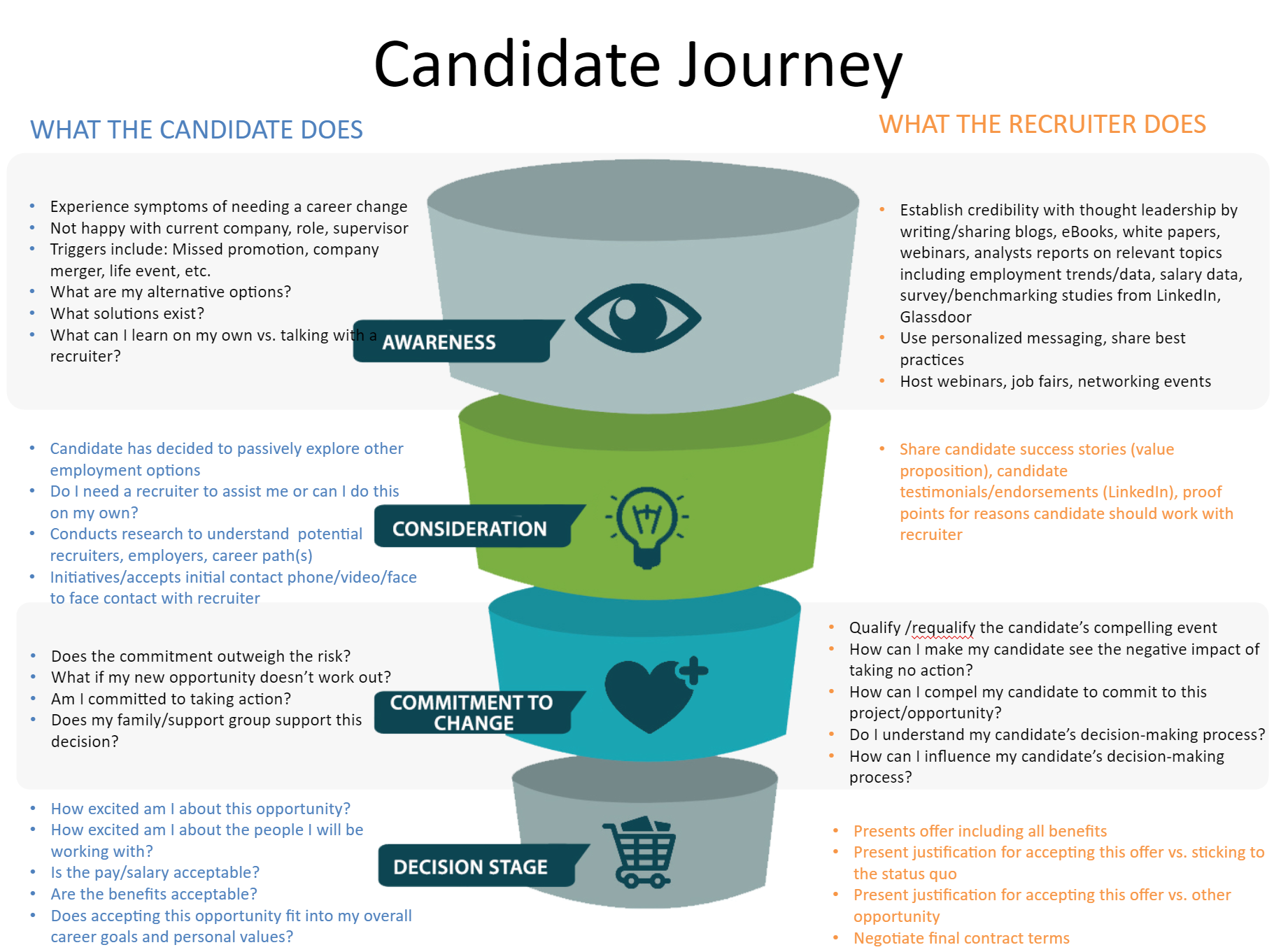1 min read
Most Staffing Firms are Not Built to Scale, But to Survive
Most staffing firms don’t struggle to scale because their teams aren’t working hard. They struggle because they don’t have a real go-to-market...

Given the uncertain and turbulent times we're living in, I thought now would be the opportune time to remind recruiters of the correct definition and importance of candidate pipelining. If you're an IT recruiter, now might be the best time and the EASIEST time to be pipelining candidates.
What is Candidate Pipelinning?
Most recruiters think of a candidate pipeline as a “list” or a “tear sheet” of pre-screened candidates that go into their pool ready and able to assume recently vacated or newly created positions. While this is a commonly accepted definition, there is one major flaw with it. The words “pool,” “tear-sheet,” and “list” imply that a candidate pipeline is static, that it is a noun or a “thing.” Sure, uploading the candidate resume and creating a candidate profile in your ATS is one aspect of candidate pipelining, but it’s only the tip of the iceberg. Recruiters must stop thinking of a candidate pipeline as a “pool'' or a noun. Instead, recruiters must start thinking of candidate pipelining as an activity and a behavior. Candidate pipelining is a continuous ongoing process and key to executing the candidate interview (it makes it easier and quicker).
At Menemsha Group, we define candidate pipelining as the following:
"Candidate pipelining is the proactive and purposeful process of identifying, qualifying and continuously engaging active and passive candidates throughout the candidate journey toward an eventual hire."
Candidate pipelining is so much more than simply adding a candidate to a “list” or “tear sheet” soon to be forgotten and never called on again. And candidate pipelining is much more than simply sending an email blast or sending a monthly newsletter. When executed properly, candidate pipelining is done with specific intent and follows a consistent and repeated cadence over a period of weeks and often months with the goal of advancing each candidate through each stage of the candidate journey and converting them to a placement. Candidate pipelining is akin to salespeople consistently calling on and engaging prospective buyers throughout the sales process until they convert the prospect into a paying customer.
Historically, recruiting has always by and large, been a reactive game. New positions are created and recruiters are tasked with reacting by recruiting talent to fill those jobs. The challenge however is the market has changed; it’s getting harder and harder to find great talent. Simply reacting is no longer good enough. Time to hire is increasing. Cost per hire is increasing. Today, just about every company is competing for the same limited pool of highly-skilled talent, making it increasingly difficult to convince the best candidates to choose your opportunity. As a result, smart staffing and recruiting firms are placing a bigger emphasis on pipelining and nurturing passive candidates in their recruiter training and onboarding program than ever before, breathing new life into the concept of candidate pipelining.
Candidate Pipeline vs. Resume Database, Tear Sheets and “Candidate Pools”
A resume database, candidate pools and candidate tear sheets or lists are nothing more than a collection of people’s resumes and/or profiles. A candidate pipeline however is:
Why Build Candidate Pipelines?
At the most basic level, there is really no value to the hiring manager if all you are doing is pulling candidate resumes from the job boards. The hiring manager expects recruiters to present candidates NOT found on the job boards. You “pipeline” candidates because the candidate’s skills, work experience, and traits match a particular skill set, job function or particular role for which there is consistent and strong demand. You may also pipeline candidates because the candidate’s skills, work experience and traits are very unique, hard to find and infrequently available in the marketplace. For example, if you’re an IT recruiter and you know most employers seek full stack engineers, you would want to pipeline full stack engineers even when you don’t have an immediate job opportunity to place a full stack engineer.
Cultivating and actively maintaining candidate pipelines will give you the greatest return on your investment of time and energy. If you’re always relying on having to identify and engage a brand new candidate whom you’ve never spoken with before for every job you work and candidate you submit then you will struggle to make placements on a consistent basis. Not only that, you will have to exert more time and more energy than what is necessary. Building candidate pipelines is about working smarter to improve your efficiency and effectiveness. Other reasons for and benefits to pipelining candidates include:
Which Candidates Qualify for My Candidate Pipeline?
You should focus on pipelining candidates who possess the relevant work experience and skills your business recruits for repeatedly and consistently for, over and over. The key to good pipelining is thinking strategically about which roles actually need a candidate pipeline. This will help you avoid wasting time or resources on roles that don’t really demand a long-term strategy.
You’re likely to get the greatest return on investment from candidate pipelines focused on hard-to-fill roles or positions you hire for frequently, like those with high turnover. Having engaged and interested candidates already in mind for these roles can significantly cut down your time to hire and ensure the roles don’t stay vacant for long.
LinkedIn Talent Insights can help you gain a better understanding of which roles you would benefit most from having pipelines. Using LinkedIn Talent Insights, you can quickly gauge hiring and departure trends with defined markets and companies and learn what skills you may need for the future, and assess the availability of local talent.
To begin pipelining for a particular skill set or role, you might start pipelining candidates who were finalists for certain roles but not hired. You will want to create a profile of them in your ATS and create a follow up task to remind yourself to stay in contact with them via phone, email and/or text every 30-45 days. Just be sure to create a candidate call plan before engaging your candidates.
Depending on the size of your company and complexity of your recruiting needs, you will likely need to create multiple pipelines segmented by role, skill set, and potentially other criteria. In some instances you may need to create multiple candidate pipelines for the same role. For example, you might have a pipeline of candidates for project managers. But you might further segment that candidate pipeline by candidates who have their PMP certification vs. those who don’t. You might also segment it even further based on location or functional vertical industry experience such as healthcare or financial services. The greater your candidate pipeline is segmented, the greater your odds are of quickly sourcing and consistently placing candidate. An effective recruiter training program incorporates all of the elements of candidate pipelining and requires recruiters to physically demonstrate that they understand how to engage in the activity of candidate pipelining.
Understanding the Candidate Journey
What is the candidate journey? The candidate journey is the process candidate’s go through to become aware of and evaluate recruiters, and new employment opportunities, and eventually accept a new job with a new employer. At a high level, candidates progress through four stages:
Nurturing Candidates in Your Pipeline
Now that we understand the candidate journey let’s turn our attention to nurturing candidates in your candidate pipeline. As mentioned previously, candidate pipelining is the proactive and purposeful process of identifying, qualifying and continuously engaging candidates throughout the candidate journey toward an eventual hire. Let’s focus on the part that says continuously engaging candidates throughout the candidate journey. We like to refer to this aspect of candidate pipelining as candidate nurturing. Candidate nurturing simply refers to recruiters consistently engaging in candidate outreach via phone calls, text messages, email and social media toward an eventual hire. Remember, candidate pipelining is an activity and a behavior, not a noun or a “thing.”
Rule number one with candidate nurturing is Do NOT make your personal goal of making a placement the focal point of your messaging. If you make your own personal, self-serving agenda-placing the candidate-the focus of your candidate nurturing campaign your candidates will see right through it from a mile away and tune you out. Candidate nurturing is about engaging your candidates in meaningful conversations, so shift your focus away from what you need and instead focus on facilitating open-ended discussions about the candidates goals and what is important to them. The focus of your candidate nurturing campaign is for you to add value and build trust with your candidate with each and every interaction. To ensure your candidate nurturing campaign adds value and builds trust, your content and messaging needs to align with the stages of the candidate’s journey.
The illustration below depicts the candidate journey.

The left hand side of the funnel depicts the things the candidate thinks about, the activities they participate in and the decisions they must make for each stage. The right hand side of the funnel depicts the the things the recruiter thinks about, the activities they should participate in and the decisions they must make for each stage.
After looking at this illustration I think we would all agree that understanding the candidate’s perspective is pretty important. Candidates have many options to consider and decisions to make when trying to select a recruiter and make a career decision. So why don’t more recruiters take the time to better understand the candidate’s perspective? Because they’re mostly focused on what they’re going to say and pitching their job opportunity. Instead, recruiters should be aligning their messaging with their candidate and where their candidate resides in the candidate journey.
Perhaps now you understand why the title of this blog, The ACTIVITY of Candidate Pipelinning and the word activity is in all caps. More importantly, hopefully you have now learned something new about candidate pipelining and how to nurture your candidates.

1 min read
Most staffing firms don’t struggle to scale because their teams aren’t working hard. They struggle because they don’t have a real go-to-market...

In my previous post, How to Prevent Unexpected Contract Terminations, I shared how systemizing consultant and client check-ins at key milestones...

About a year ago, I was serving as the fractional revenue leader, managing sales and recruiting for a client.